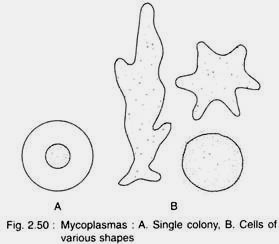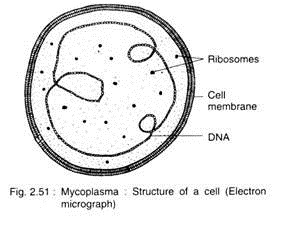In this article we will discuss about:- 1. Discovery of Mycoplasmas 2. Classification of Mycoplasmas 3. Structure 4. Diseases Caused.
Discovery of Mycoplasmas:
Mycoplasmas are the smallest among the known aerobic prokaryotes (Fig. 2.50). They were first discovered by Pasteur in 1843, during his work on the possible causal agent of pleuropneumonia of cattle. Thus they were called pleuro- pneumonia-like organism (PPLO).
Pasteur was unable to isolate them in pure culture. Later, Nocard and Roux (1898), the French microbiologists, were successful in growing them in pure culture-medium containing serum and confirmed . by inoculation and subsequent expression of disease in healthy cattle.
Mycoplasmas are commonly found in soil, hot spring, sewage water and also in plants and animals including man. Borrel (1910) named these organisms Asterococcus mycoides. Later, in 1929, Nowak placed them under the genus Mycoplasma.
Classification of Mycoplasmas:
Based on nutritional requirement, mycoplasmas are divided into the following three genera:
1. Mycoplasma:
They require cholesterol for their growth. They parasitise on animals including man by causing damage to the mucous membranes and different joints of the body.
2. Acholeplasma:
They do not require cholesterol for their growth. They are available in sewage water and soil as saprophytes and in vertebrates and also in plants as parasites.
3. Thermoplasma:
They also do not require cholesterol for their growth. They are aerobic microorganisms showing good growth in acidic pH between 0.96-3.0, with an optimum temperature of 59°C.
Structure of Mycoplasmas:
The cell is devoid of cell wall which makes them readily deformable showing irregular and variable shapes. They may be ring-like, granular, coccoid, pear-shaped, filamentous, etc. (Fig. 2.50). The filaments are of two types: unbranched or branched. The cells are very small and measure 0.3-0.9 µm in diameter.
The cells are covered by cytoplasmic (lipoprotein) membrane (Fig. 2.51). Cell membrane covers the cytoplasm which contains nucleoplasm like structure and ribosomes. The genetic material is composed of DNA and RNA. It is about less than 50%, the amount present in other prokaryotic organisms. The amount of RNA (8%) is more than DNA (4%).
They are usually non-motile, but some forms show gliding movements. They reproduce by vegetative means i.e., by binary fission and budding.
They are sensitive to antibiotics like chloramphenicol, streptomycin, erythromycin etc., but are insensitive to penicillin, ampicillin etc., due to the absence of cell wall.
Diseases Caused by Mycoplasma:
Mycoplasmas cause different serious diseases in plants and animals including man.
Some of these are:
(a) Plant Diseases:
(i) Little leaf disease of brinjal,
(ii) Bunchy top of papaya,
(iii) Big bud of tomato,
(iv) Witches broom of legumes,
(v) Yellow dwarf of tobacco,
(vi) Strip disease of sugarcane,
(vii) Clover dwarf,
(viii) Cotton vires- cence.
(b) Human Diseases:
(i) Primary atypical pneumonia (PAP) by Mycoplasma pneumoniae,
(ii) Mycoplasma hominis causes pleuropneumonia, prostatitis, inflammations of genitals etc.
(iii) Mycoplasma fermentants causes infertility in man.
(c) Animal Diseases:
(i) Mycoplasma agalactia causes agalactia of goat and sheep,
(ii) Mycoplasma mycoides causes pleuropneumonia of cattle,
(iii) M. bovigenitalium causes inflammation of genitals of different animals.

